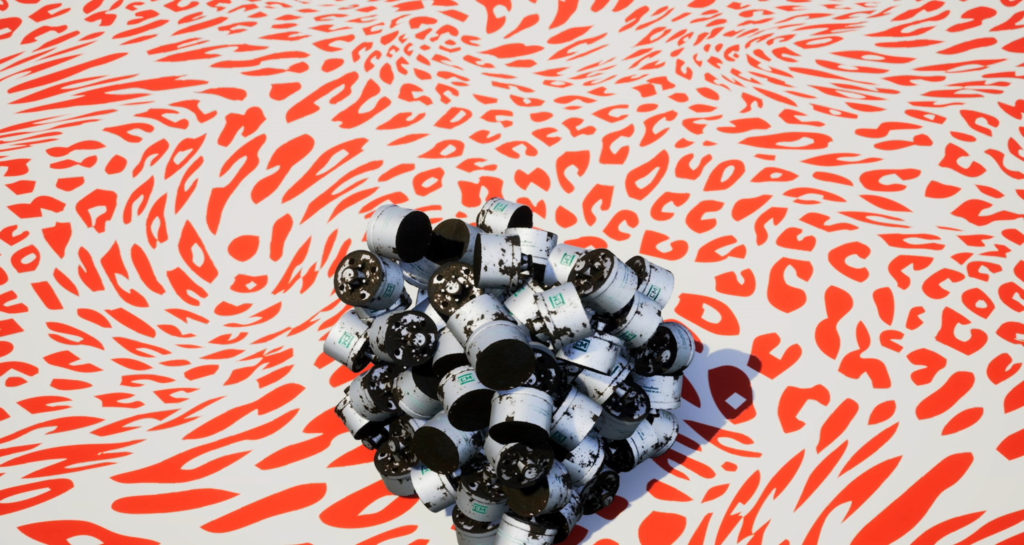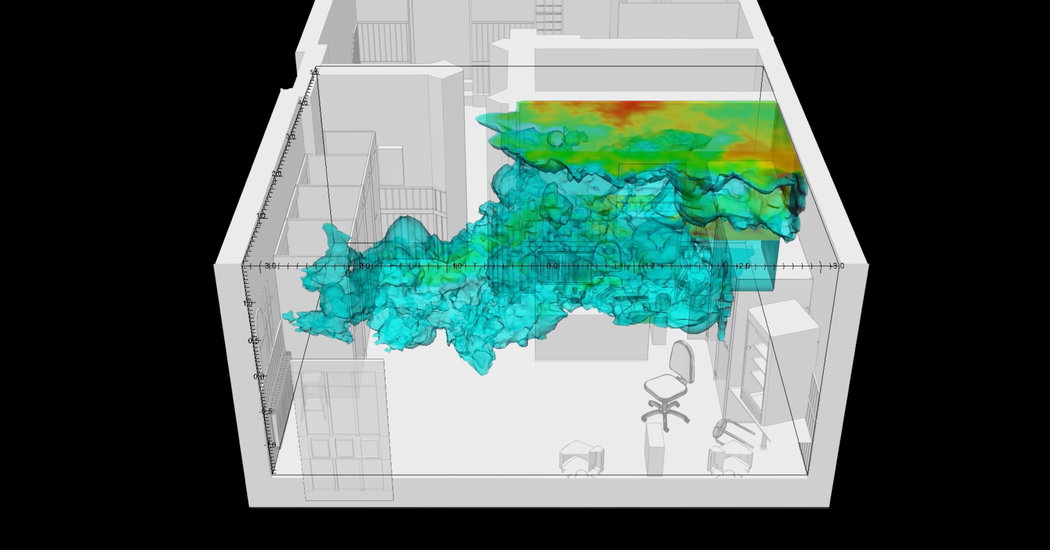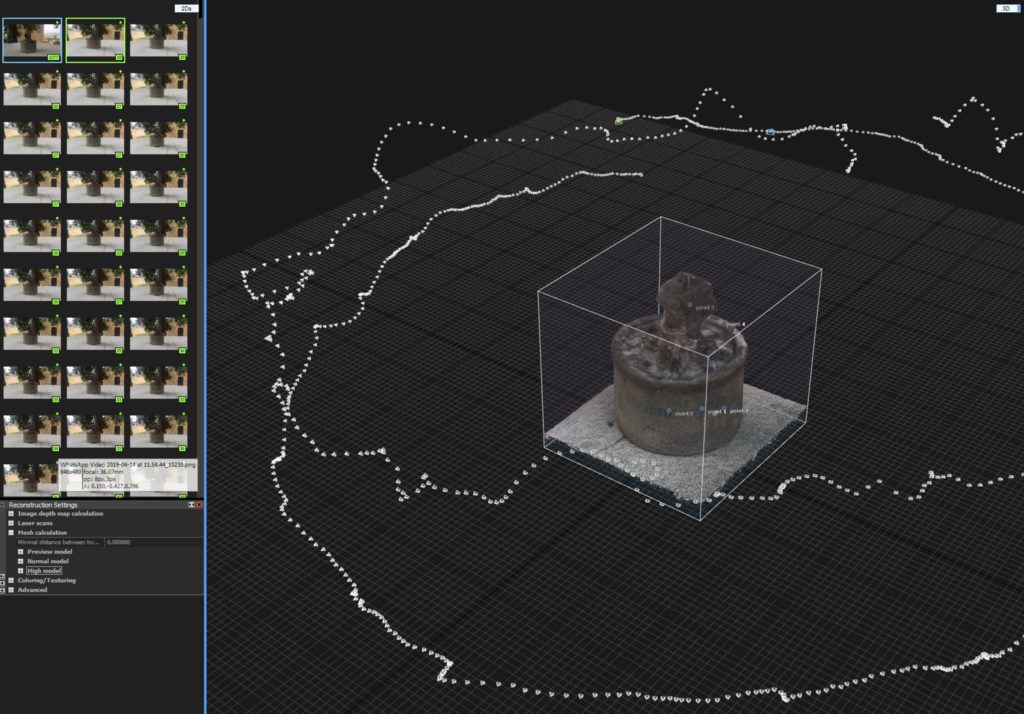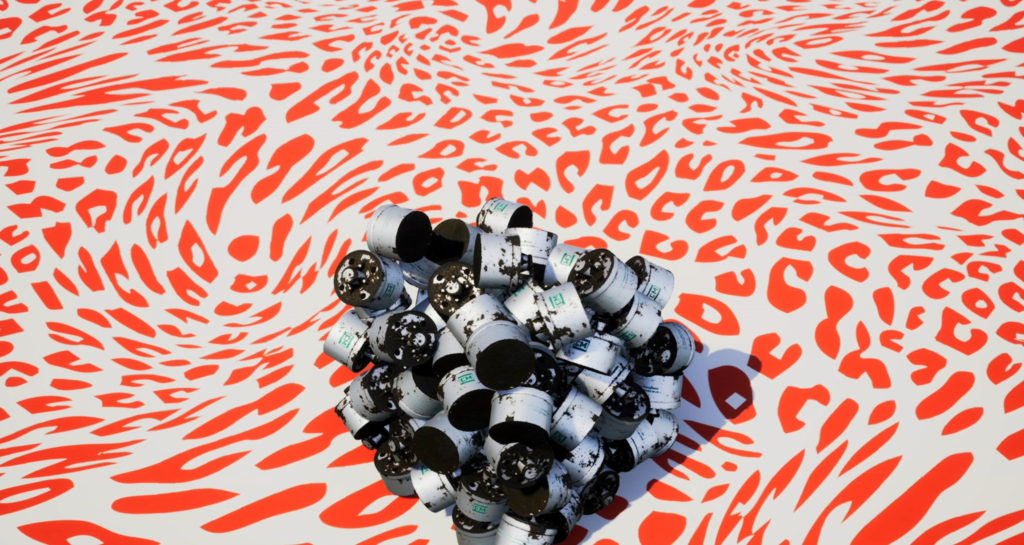[ad_1]

Forensic Architecture and Praxis Films, Triple Chaser (still), 2019.
COURTESY THE ARTISTS
‘You see flashes in your eyes. You taste too much. You smell too much. It burns you everywhere.” These are the effects of tear gas on the human body, Eyal Weizman of the politically minded research agency Forensic Architecture, told me in a recent interview. This week, the group will appear in the Whitney Biennial, which opens amid protests against the museum for a board member’s ties to the manufacture of tear-gas canisters. Weizman continued, “Your ears are ringing. You have a condition of hyperesthesia—overexposure to sensory stimuli. I can say this from experience.”
It used to be possible to curtail the effects of tear gas. “You [put a] lemon on your mouth or nose,” said Weizman, who founded Forensic Architecture in London in 2010. But manufacturers engineered a new kind of canister known as a triple chaser, which splits into three parts once it hits the ground, making it difficult to control.
Safariland, a Jacksonville, Florida–based defense manufacturing company that produces triple chasers, is run by Warren B. Kanders, the vice chair of the Whitney Museum’s board. In November of last year, Hyperallergic reported on Kanders’s role as the company’s chairman and chief executive—and exposed instances of Safariland products being thrown at asylum seekers along the border between the U.S. and Mexico. In response to that and other findings—including instances of Safariland products’ use in politically fractious situations all over the globe—about 100 Whitney staffers signed an open letter calling on Adam Weinberg, the museum’s director, and other administrators to consider asking for Kanders’s resignation.
The controversy has swelled and intensified since. Days after the open letter, Weinberg encouraged a dialogue among museum staffers about Kanders’s involvement with the institution, and Kanders issued a defense of his company and himself in which he said he was “not the problem.” The collective Decolonize This Place has since staged a series of actions at the museum that have attracted dozens upon dozens demonstrators chanting disruptive slogans in the museum’s lobby and its since-closed Andy Warhol retrospective. In a significant show of dissent, in April, the Brooklyn-based publishing house Verso Books, published an open letter calling for Kanders’s removal, signed by 120 academics and critics. Several weeks later, nearly half of the artists in the Whitney Biennial opening on Friday added their names to the list.
One notable signee was Forensic Architecture. Since its founding, the agency—which comprises about 20 full-time researchers, filmmakers, and technologists, along with a team of fellows—has been devoted to in-depth investigations of conflict, violence, and corruption in global politics. Often their research delves into pointed mysteries, such as the killing of the queer activist Zak Kostopoulos in Athens last year, and seeks to uncover potential cover-ups. Another line of pursuit concerned agricultural corporations that caused a fire that spread across Indonesia in 2015 and consumed thousands of square miles of land. Yet another looked into the 2015 shooting of a Kurdish human rights lawyer in Turkey and identified suspects that investigators had failed to consider. The results of such investigations, obtained through obsessive examination of photographs, data, and maps, are often compiled and sent to authorities. They are also reconstituted as artworks filled with audio, documentary films presenting the group’s findings, and diagrams that run across the surrounding floor and walls.
Forensic Architecture has enlisted artists, filmmakers, writers, data analysts, technologists, and academics in an intensively collaborative process. Maps and digital animations often play a critical role in the group’s work, allowing for painstaking recreations of shootings and disasters, and images are often culled from social media and scrutinized for information. Forensic Architecture’s work suggests a union of institutional critique and post-internet aesthetics, and it exists in many forms. On the group’s website, it lives as design-heavy interactive presentations. In museums, their work takes the form of installations dense with videos, diagrams, and elements of sound.
For the Whitney Biennial, Forensic Architecture will debut a custom form of artificial intelligence that, through the analysis of images of protests around the world, may ultimately be able to identify instances in which tear-gas canisters produced by Safariland have been deployed. Presented at the Biennial will be Triple Chaser (2019), a film about the machine-learning algorithm made by Laura Poitras—the documentarian behind Citizenfour (2014), about the U.S. government whistleblower Edward Snowden—and her organization, Praxis Films, in collaboration with Forensic Architecture. First teased in a cryptic tweet in which the group said it would respond to “a challenge which unites the political & cultural dimensions of our practice” in February, Forensic Architecture’s works promises to be among the Biennial’s most talked-about presentations.

A still from a video related to a 2017 Forensic Architecture investigation into the 2006 murder of Halit Yozgat in Kassel, Germany.
COURTESY THE ARTIST
Forensic Architecture has become notorious for responding quickly and pointedly to controversies as they arise, and sure enough, on the morning I visited the group’s office in London, a crisis was underway, after reports flooded the media with news that Julian Assange, the controversial WikiLeaks founder, had been ejected from his home of nearly seven years in the Ecuadorian embassy in London and arrested on a U.S. hacking conspiracy charge.
Forensic Architecture sprang into action. While researchers and technologists continued typing away at one bank of desks, a crew of employees assembled around a computer. Working with Poitras, they drafted a statement that was posted to Forensic Architecture’s website the day after Assange’s arrest. “The pioneering work of Wikileaks shattered every established paradigm of public interest journalism, and ushered in a new era of investigative reporting,” the group wrote.
After the commotion died down, the office was hushed. Light spilled in through tall windows, illuminating a virtual-reality headset and a book by the theorist Nezar AlSayyad on a table. A whiteboard was filled with sketches of ideas and a kitchenette greeted workers who availed themselves of coffee. It was more like the office space of an architecture firm than an art studio.
Asked about a hybrid kind of work that has occupied a complex middle-ground between experimental architecture, investigative reporting, and human-rights activism, Weizman, in his thick Israeli accent, said, “Aesthetics is the doorway into research.” One of his first major projects came in 2002, at the request of the Israeli human rights group B’Tselem. Weizman—who is 48, and was born and raised in Israel—undertook the extensive effort of mapping settlements in the West Bank. This was before maps captured by satellites were widely available online, and Weizman realized, years later, that all the physical labor that went into such mapping could have been accomplished at a computer. “I thought, ‘Oh god, I could’ve done this whole work in a day,’ ” he said. The realization got him thinking about the role that images play in collective understandings of cross-national conflicts, as well as how design can often be a violent force in the world.
Forensic Architecture came together, in 2010, when a group of researchers assembled around Weizman at Goldsmiths, as part of the school’s larger Centre for Research Architecture program. (Forensic Oceanography, a separate group devoted specifically to inquiries related to international waters, also grew out of the center, and artist Lawrence Abu Hamdan, who is nominated for this year’s Turner Prize and is a frequent collaborator with Forensic Architecture, studied at the center as a Ph.D. student.) Since then, Forensic Architecture has often worked on projects commissioned by activist and journalistic organizations looking for Forensic Architecture’s unique perspective on matters of global import. In 2015, Amnesty International had Forensic Architecture look into the torture and killings of Cameroonian citizens by the terrorist group Boko Haram. In 2018, the New York Times commissioned the group to investigate the death of a Palestinian medic who shot by Israeli forces at a protest.
Museums have also embraced the fluidity Forensic Architecture’s work, which stretches the boundaries of art. “Within the space of an art museum, I think Forensic Architecture’s emphasis on the visual feels even more foregrounded,” Jane Panetta, who curated this year’s Whitney Biennial with Rujeko Hockley, said in an email. “So often, their research leads with an emphasis on seeing or re-seeing events, something they achieve through their use of open source imagery and careful composing of individual frames within their videos. Ultimately, these strategies take on renewed significance in the context of a museum—a space with an inherent and consistent emphasis on relaying information through visual means.”
But this boundary-pushing has worked in different directions. Last year, after Forensic Architecture was nominated for the Turner Prize, Phineas Harper, a design curator currently at work on the forthcoming Oslo Architecture Triennale, wrote in an Op-Ed in Dezeen that the art world’s embrace of the group risked “turning sensitive essential investigative work into insensitive frivolous entertainment.”
Forensic Architecture has made itself an arbiter in some of the world’s major conflicts, often by acting as a bystander whose goal is to communicate the truth. But, as it prepares to show a work in one of the most contentious art exhibitions in recent memory, can the group remain impartial?

Forensic Architecture and Praxis Films, Triple Chaser (still), 2019.
COURTESY THE ARTISTS
Forensic Architecture’s work for the Whitney is unlike anything it has produced before. Whereas it has previously been concerned with past events, this time the group is anticipating future scenarios relating to triple-chaser canisters of tear gas. How will it be used in protests yet to come? Can a machine-learning algorithm help researchers understand tear gas’ potential impacts?
In London, Lachlan Kermode, a researcher and software development lead at Forensic Architecture, pulled up a PowerPoint presentation on two computer screens to show how the inner mechanisms of their Whitney Biennial work—an algorithm called a classifier that can identify, through machine-learning and artificial intelligence, certain elements within a given image. (At the Biennial, the classifier will be presented as a link displayed through wall text, alongside the video produced by Poitras and Praxis Films.) With Unreal Engine, a software program used to design video games, Kermode and game developer Alican Aktürk created grids of still images from videos of protests on YouTube and social media. They then annotated the images with terms like “canister” and “Tijuana,” to characterize some 500 images that are then loaded into machine-learning software. In their raw form, most of the images are blurry, low-resolution pictures that reflect states of chaos and confusion during times of conflict. But Kermode insisted the algorithm would be able to recognize elements within them. “There’s a tank in the frame,” Kermode said while pointing out an object the artificial intelligence had no problem seeing.
A challenge for the future is finding ways to use such technology ethically, Kermode said. “There are many ways in which classifiers have been used, sometimes very constructively, but they’ve often been used in military applications. They’re really good at finding relations between images, but just because this image looks like a tank or a person doesn’t mean you should fire at them with a drone. The classifier could be wrong. We really don’t want to use machine learning in an inappropriate way.”
Ethics of a different sort are also the subject of Poitras and Forensic Architecture’s film, Triple Chaser, which, in a matter of less than 15 minutes, cleanly, clinically, and shockingly lays bare Kanders’s roles at Safariland and the Whitney, and goes on to document his part in other defense-manufacturing companies and cultural institutions.
Poitras is friends with Weizman and saw images of the group of images collected by Kermode and Aktürk—what’s known as a synthetic dataset—on a computer screen on visit to the agency’s office in March. She was intrigued by how, through a moving-image work, she could portray the group’s interest in “trauma and memory retrieval,” she said. Having had a Whitney solo show herself in 2016, she felt she had to get involved.
Triple Chaser is narrated by David Byrne (the musician and former frontman of Talking Heads) and split into chapters that guide the viewer through the history of Safariland, the making of Forensic Architecture’s classifier, the effects of tear gas on the human body, the use of tear gas in Turkey’s Gezi Park protests, and the role Kanders plays in Sierra Bullets, a company that makes ammunition that has been used by the Israel Defense Forces. (Sierra Bullets is owned by the holding company Clarus, which lists Kanders as its executive chairman. In prior interviews, Kanders has said that a Sierra bullet killed Osama bin Laden.) Over the course of the film, Poitras and Forensic Architecture expand their inquiry beyond the Whitney and moves into Kanders’s philanthropic efforts, including a $2.5 million donation he and his wife Allison Kanders made to the Aspen Music Festival in 2016.
The film shows that his philanthropic endeavors have extended beyond one New York museum, and encourages viewers to further investigate his dealings. The film’s most memorable section is a centerpiece in which Richard Strauss’s Four Last Songs (1948)—a composition performed at the Aspen Music Festival the year of the donation—plays over an image of a computer-generated a 3D model of a pile of Safariland triple chasers floating in a digital void. The swooning vocals and swelling strings are majestic, but brightly colored abstract patterns flash incessantly cause the shot to strobe and become nearly unwatchable.
For Poitras, the controversy surrounding Kanders is an important example of what can result come from increased awareness of the funder of art institutions. “We’re starting to see that the public is being confronted with abuses of power and money with high culture,” she said. “Let’s put those in juxtaposition and let the public confront those contradictions and call them into question.”
By Weizman’s own admission, Forensic Architecture’s algorithm is not yet complete. It will require further labor to become a reliable tool that researchers can use with accuracy. But even in its in-progress state, Forensic Architecture’s classifier may have real-world effects. “It’s a beta,” Weizman said. “But it’s a good beta!”
[ad_2]
Source link

